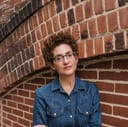Stay in the Loop
BSR publishes on a weekly schedule, with an email newsletter every Wednesday and Thursday morning. There’s no paywall, and subscribing is always free.
Street dance dazzles in the shadows
Penn Live Arts presents Ephrat Asherie Dance’s Shadow Cities, with Arturo O’Farrill

Lovers of live music and dance met at Penn Live Arts to see titans of Afro-Latin jazz and club and street dance meet onstage. Legendary jazz musician Arturo O’Farrill joined Ephrat Asherie Dance (EAD), a company dedicated to exploring African American and Latine street and club dance. The artists reflected on the creative possibilities of the in-between in Shadow Cities, an interdisciplinary world premiere about meeting in the margins.
If you don’t know EAD, you should. Ephrat “Bounce” Asherie is an Israeli-born American and award-winning b-girl, or female breakdancer. She is the artistic director of EAD, a dance company that explores the power and possibility of dance forms such as breaking, hip hop, house, and vogue. Styles like these are culturally important and artistically significant, yet still receive less recognition than classical and canonized dance forms (like ballet, jazz, and modern). They are more inclusive, too, emphasizing skill over aesthetics based on size, shape, and gender norms.
Virtuoso music and dance
Asherie’s past guest performances with Dorrance Dance blew me away, and her company’s approach to breaking resembles what Dorrance does for tap in honoring the heritage, building on it, and raising awareness and appreciation on concert stages around the world. Shadow Cities, a co-commission from Penn Live Arts, goes even further in connecting street and club dance to Afro-Latin jazz.
It synthesized virtuoso music and dancing into a performance greater than the sum of its parts. The musicians and their instruments shared the stage with dancers Asherie, Manon Bal, Ron “Stealth-1” Chunn, Teena Marie Custer, Val “Ms Vee” Ho, Eriko Jimbo, and Dorren “Moglii” Smith. They seemed to converse, as well, incorporating a substantial amount of improvisation. O’Farrill’s piano engaged with the dancers, as did Juan Carlos Polo’s percussion, Eduardo Belo’s upright bass, and Alfredo Colon’s saxophones, clarinet, and flute.
O’Farrill composed and performed live alongside three fellow musicians and seven dancers. From my seat, I could see him leaning his arm on the piano as he watched the dancers during one sequence. His hand, inside the instrument, plucked its strings in a rhythm emphasizing their footwork. Each of the musicians took a turn soloing with the dancers in this way. Belo hoisted his bass and moved among the dancers as he played. Ho and Colon performed a kinesthetic duet in which the sounds of his flute and breath seemed to propel her robotic movements.

The percussion solo incorporated small wooden boxes that the dancers used as props throughout Shadow Cities. The boxes were arranged into the shape of a city skyline and carried like suitcases, creating images of travel, migration, and innovation. Dancers stacked them and stood, moved, and balanced on top. Then four of them sat on their boxes in a circle around Polo, mimicking his posture as he beat a rhythm with his hands. The dancers then interacted with their boxes and each other to the beat.
Enjoying the in-between
Production elements added even more nuance to Shadow Cities. David Dalrymple’s costume design conveyed both individuality and community. The dancers wore sneakers and colorful streetwear with elements of red and yellow, evoking the flags of several Spanish-speaking countries. Kathy Kaufmann’s lighting allowed the dancers to create shapes in shadow. Meanwhile, projections of colored squares resembled the paintings of Mark Rothko, whose use of color creates the illusion of depth and even movement. In Rothko’s paintings, some shapes appear to float or advance toward the viewer, while others sink or retreat. The squares create in-between or shadow spaces on the canvas, echoing the themes of Shadow Cities.
Earlier this year, I called for more street dance performances at Philadelphia venues, and Shadow Cities delivered. The lean, 60-minute runtime highlighted creative practices and processes that invite collaboration and are inherently, infinitely generative. There was dancing and music, but the show was more than that. Dancers and musicians layered movement, sound, and rhythm in ways that highlighted the fluid potential of the shadowy in-between.
What, When, Where
Shadow Cities, featuring Ephrat Asherie Dance with Arturo O’Farrill. $40-79 November 14-15, 2025 at the Annenberg Center at Penn Live Arts, 3680 Walnut Street, Philadelphia. PennLiveArts.com.
What, When, Where
The Annenberg Center is a wheelchair-accessible and sensory inclusive certified venue with large-print programs and assisted listening devices available. For more info, visit the accessibility page.
Sign up for our newsletter
All of the week's new articles, all in one place. Sign up for the free weekly BSR newsletters, and don't miss a conversation.

 Melissa Strong
Melissa Strong